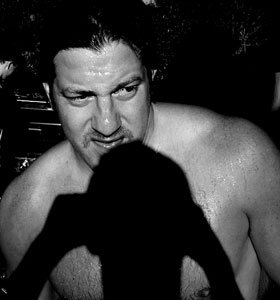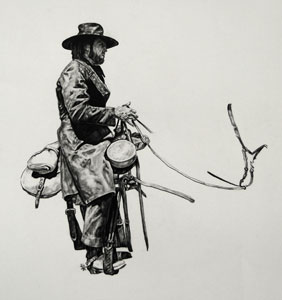



"Medium" to me is really an obsolete category in regards to the creation of artwork. I believe firmly in doing what I want and using whatever medium necessary in order to fulfill my conceptual interests. Coming from a painting and drawing background, I naturally tend towards two-dimensional works, but that is something I hope to continue to work on in the future. I believe that developing a diverse skill-set and artistic language is beneficial to any artist. Limitation is useful for accessibility and categorization, but not necessarily for artistic advancement.
I believe my artwork benefits by feeding off of itself. In this way, my work is best displayed in a series or a space that can display a multifaceted installation.
The challenge that I face most in my artwork generally involves how to completely finish a piece. I work on numerous artworks at the same time, and very often I consider something complete after I reach a conceptual end. The real work, for me, involves how to display this conceptual end to the viewer - allowing them to understand my process without disrespecting their right to a unique experience with it. Finishing a work involves a complex relationship with space, and I am learning how to adjust my process to compensate for this endpoint.
One discovery I have made while working is that I do not benefit from being frustrated in terms of the creation of art. If I am not enjoying the piece that I am working on or if I don't like the way it is turning out, I find that it is most beneficial to move on to another work before giving in to frustration (Unless, of course, the piece that I am working on is based on frustration or dissatisfaction). As an artist that balances impulse with calculation, I often react to frustration with recklessness. And because I often get frustrated at the most important and / or difficult moments of the creation of my work, I allow myself to really take my time and evaluate what solution would best serve my work. I would rather be disappointed in a work that I can improve than angry at a mess I cannot remake. If I begin to get frustrated or scared, I take a minute to re-evaluate and decide how to move forward without feeling those things.
I believe the role of the artist in society is to ask questions and to advance the cause of creativity. Everyone on this planet has their own beliefs and opinions, but I think it is important to be faced with challenges to these beliefs in order to reaffirm how and why we believe what we think we do. In addition, I think many people disregard creativity as an important asset in a larger social context. The constant questioning of reality and the advancement of creativity is an important tool to enhance personal freedom in whatever individual form that may take. The artist is uniquely positioned to formulate these important questions - challenging or reaffirming the established order - inherently propagating new thoughts and new actions in a society.
The advice that I would give a young artist is to never be scared. Being scared is the death of the artist. When one is scared, one is instantly acknowledging outside control over one's artwork - whether through social pressure or even laziness. An artist should be willing to destroy their own artwork at the drop of a hat. Making art involves as much failure as it does success, and conquering failure is the only way to achieve success.

There are a couple of orders of business to tackle before you go on reading:
1. I've heard that the moment a person becomes addicted to drugs or alcohol their body instantly arrests its emotional growth because they never learn to cope with issues like non-addicts do. But what is coping and how is it different than abusing a substance?
2. Scientists have recently theorized that at a black hole’s event horizon, three-dimensions may actually exist as two dimensions. In this way, the universe may actually exist as a virtual hologram.
But what do these issues have to do with art?
In my work, I create imagery that subverts conventional structures of representation - exploring notions of masculinity, futility, reality and object-hood. This language gets reformed and pieced together as a puzzle, becoming a study of what exist between the words we say - a recontextualization of images we see and the thoughts that we have - questioning the limitations of media, myth, and the conscious knowledge that forms our personal and social realities. Like the hologram that could be our universe, or the coping that resembles substance abuse, these works play off of ideas that are deemed as truthful and redeposits them into different forms.
Built out of drawings, photographs, videos and projections, these works combine to form a semi-autobiographical challenge to the notion of who I am – who we all are – progressing the discourse of what it means to live within or outside of these arbitrary social boundaries.

Massimo Pacchione was born and raised in Philadelphia, Pennsylvania. From a very early age, Massimo found himself interested in art and science, studying both in various forms through college. Minoring in Biology and double majoring in Art History and Fine Arts at James Madison University, Massimo was the recipient of the university's Art History Award and finalist for the Studio Arts Achievement Award. After college, Massimo moved to Los Angeles, California where he worked in documentary commercial production while also continuing his artistic production in a Santa Monica studio. In 2009, Massimo was accepted into the MFA program at SFAI for painting. His most recent work focuses on the abstract projection of the American male as told through a variety of mediums.